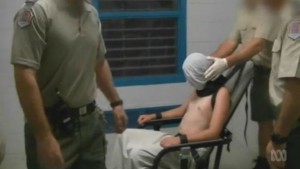Home » Commentary » Opinion » Don Dale the tip of child protection scandal
· The Australian - Inquirer
 The root causes of what leads children to end up in detention centres and similar facilities across the nation must be addressed, if the conspicuous outrage displayed by many politicians — from the Prime Minister down — is to prove more than mere gesture politics.
The root causes of what leads children to end up in detention centres and similar facilities across the nation must be addressed, if the conspicuous outrage displayed by many politicians — from the Prime Minister down — is to prove more than mere gesture politics.
Overwhelming feelings of disgust and shame were the natural responses to the Four Corners report detailing the mistreatment of indigenous youths in the Don Dale juvenile detention centre in the Northern Territory.
But, thankfully, Northern Territory Chief Minister Adam Giles has led the way by demanding the Royal Commission not only examine the problems in the corrections system, but also examine the systemic failings of the Territory’s child protection system.
Giles has rightly suggested that many of the wild and uncontrollable children who end up in gaol come from troubled family backgrounds involving chronic parental abuse and neglect.
It is essential to draw national attention to the role played by child protection in the harm done to children. The Don Dale scandal and the need to incarcerate some youths who have committed crimes is a tragic symptom — and just the tip — of a much bigger scandal.
The key issue is that the most vulnerable children suffer often irreparable harm, and lifetime disadvantage, because of flawed child protection policies that prioritise keeping deeply troubled families together at the expense of properly protecting children.
The chief problem is that child protection services in all jurisdictions practice ‘family preservation’ at almost all costs, which means too little, too late is done to rescue children. Even after children are reported time and again because of welfare concerns, they are left with even highly dysfunctional parents that have serious drug and alcohol, domestic violence and other social problems.
When finally removed as a ‘last resort’, children have been damaged by prolonged exposure to parental neglect and maltreatment. Hence many of the more than 43,000 children nationally who currently live in foster and other forms of out-of-home care have what is euphemistically described as “high needs”.
The brutal truth is that these children have a range of abuse- and neglect-related developmental, emotional, psychological or behavioural problems including depression, hyperactivity, ADHD, anxiety, post-traumatic stress disorder, sexual deviance, conduct disorder, aggression, delinquency, and poor peer relationships and social functioning.
It is no exaggeration to say that Australian child protection systems are mental illness factories.
Studies suggest that more than half of all children in care have a significant, clinically diagnosable mental illness; a much higher rate than in the general population.
The primary cause of children’s problems is the trauma endured in the family home. But this is intensified after children enter care by the instability experienced, due to the over-extended efforts made to restore them to their parents.
The way children are cycled in and out of care due to multiple failed placements and family reunions is an independent and additional cause of harm that exacerbates behavioural and other problems. Not surprisingly, studies have also shown the higher the level of instability, the higher the level of disturbance found in children.
Damaged children who have suffered abuse and neglect at home, and who have been further damaged by instability in care, end up becoming the disturbed – or ‘hard to help’ – teenagers whose traumatic childhoods are played out through challenging behaviours (crime, risk of suicide, substance abuse, and death by misadventure) at older ages.
For this severely disturbed group of young people, it is no longer safe to live in the family home. But nor is it possible for increasing numbers of these young people to live safely with normal foster or kinship care family.
Because their uncontrollable, threatening, violent, and self-destructive behaviours necessitate round-the-clock supervision by professional carers, the only suitable current placement option is residential care facilities.
The mounting and compounding problems in child protection systems have led to the number of children living in residential care more than doubling, to more than 2300 children nationally over the past decade.
Ironically, 30 years after the vast majority of large-scale orphanages were closed down, Australian governments have been forced to ‘re-institutionalise’ the care system to cater for all the children who are damaged and disturbed by family preservation.
Today, these residential institutions may well be smaller-scale ‘group homes’ with no more than six residents. However, they have a strong psychiatric care focus and include ‘secure facilities’ for the most antisocial children. These are the modern-day asylums used to lock up the ‘worst of the worst’ — the most disturbed teenagers whose behaviour poses a threat to themselves and to others.
This is the national shame of Australia’s child protection scandal, which could be massively ameliorated if governments had the will to implement the rational alternative approach — earlier and permanent removal of children and achieving stability by the use of adoption to give children new and functional families for life.
The scandalous state of child protection systems is the primary issue the Royal Commission must focus attention upon to expose the fundamental source of the shocking problems in places like Don Dale.
Jeremy Sammut is a Senior Research Fellow at The Centre for Independent Studies and author of The Madness of Australian Child Protection.
Don Dale the tip of child protection scandal